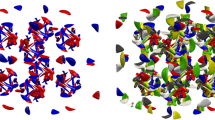Abstract
The mechanisms related to the secondary splitting of zero-gradient points of scalar fields are analyzed using the two-dimensional case of a scalar extreme point lying in a region of local strain. The velocity field is assumed to resemble a stagnation-point flow, cf. Gibson (Phys Fluids 11:2305–2315, 1968), which is approximated using a Taylor expansion up to third order. The temporal evolution of the scalar field in the vicinity of the stagnation point is derived using a series expansion, and it is found that the splitting can only be explained when the third-order terms of the Taylor expansion of the flow field are included. The non-dimensional splitting time turns out to depend on three parameters, namely the local Péclet number Pe δ based on the initial size of the extreme point δ and two parameters which are measures of the rate of change of the local strain. For the limiting casePe δ → 0, the splitting time is found to be finite but Péclet-number independent, while for the case of Pe δ → ∞ it increases logarithmically with the Péclet number. The physical implications of the two-dimensional mathematical solution are discussed and compared with the splitting times obtained numerically from a Taylor–Green vortex.
Similar content being viewed by others
References
Gibson CH (1968) Fine structure of scalar fields mixed by turbulence I. Zero gradient points and minimal gradient surfaces. Phys Fluids 11: 2305–2315
Wang L, Peters N (2006) The length scale distribution function of the distance between extremal points in passive scalar turbulence. J Fluid Mech 554: 457–475
Wang L, Peters N (2008) Length scale distribution functions and conditional means for various fields in turbulence. J Fluid Mech 608: 113–138
Schaefer P, Gampert M, Goebbert JH, Wang L, Peters N (2010) Testing of model equations for the mean dissipation using Kolmogorov Flows. Flow Turbul Combust 85: 225–243
Schaefer P, Gampert M, Wang L, Peters N (2009) Fast and slow changes of the length of gradient trajectories in homogenous shear turbulence. In: Eckhardt B (eds) Advances in turbulence XII. Springer, Berlin, pp 565–572
Dávila J, Vassilicos JC (2003) Richardson’s pair diffusion and the stagnation point structure of turbulence. Phys Rev Lett 91: 14
Goto S, Vassilicos JC (2009) The dissipation rate coefficient is not universal and depends on the internal stagnation point structure. Phys Fluids 21: 035104
Burgers JM (1974) The non-linear diffusion equation: asymptotic solutions and statistical problems. Reidel, Boston
von Neumann J (1963) In: Taub AH (ed) Collected works (1949–1963), vo1 6. Pergamon Press, New York, p 437
Frisch U, Bec J (2000) New trends in turbulence. Turbulence: Nouveaux aspects. Ecole d’Ete de Physique Theorique, Les Houches Session 74, France
Bernard PS (1990) Convective diffusion in two-dimensional incompressible linear flow. SIAM Rev 32: 660–666
Burgers JM (1948) A mathematical model illustrating the theory of turbulence. Adv Appl Mech 1: 171–199
Lingevitch JF, Bernoff AJ (1994) Advection of a passive scalar by a vortex couple in the small-diffusion limit. J Fluid Mech 270: 219–249
Villermaux E (2000) Mixing as an aggregation process. In: Pollard A, Candel S (eds) Turbulent mixing and combustion. Kluwer, Dordrecht, pp 1–21
Peters N, Wang L (2006) Dissipation element analysis of scalar fields in turbulence. C R Mecanique 334: 493–506
Bronstein IN, Semendjajev KA, Musio G, Muehlig H (2000) Handbuch der Mathematik, 5th edn. Verlag Harri Deutsch, Thun und Frankfurt am Main
Author information
Authors and Affiliations
Corresponding author
Rights and permissions
About this article
Cite this article
Schaefer, P., Gampert, M., Gauding, M. et al. The secondary splitting of zero-gradient points in a scalar field. J Eng Math 71, 81–95 (2011). https://doi.org/10.1007/s10665-011-9452-x
Received:
Accepted:
Published:
Issue Date:
DOI: https://doi.org/10.1007/s10665-011-9452-x




